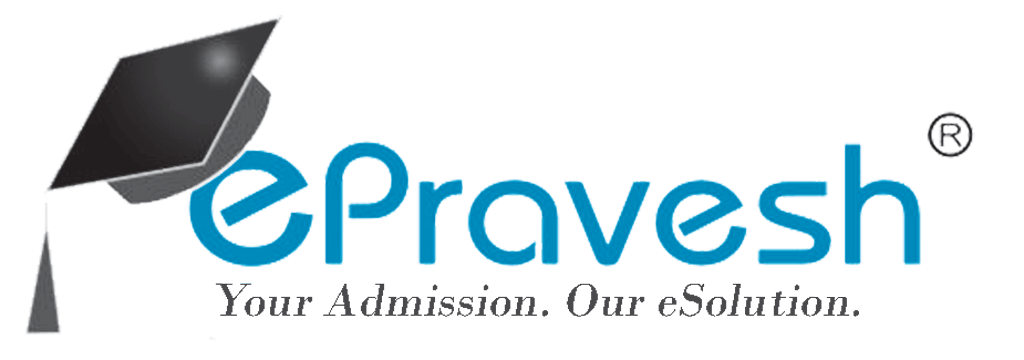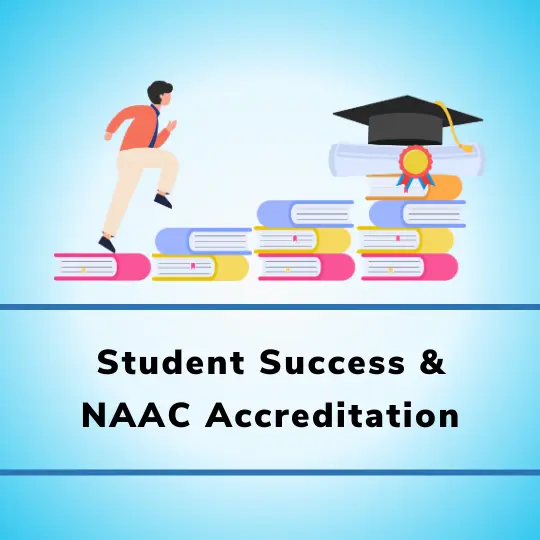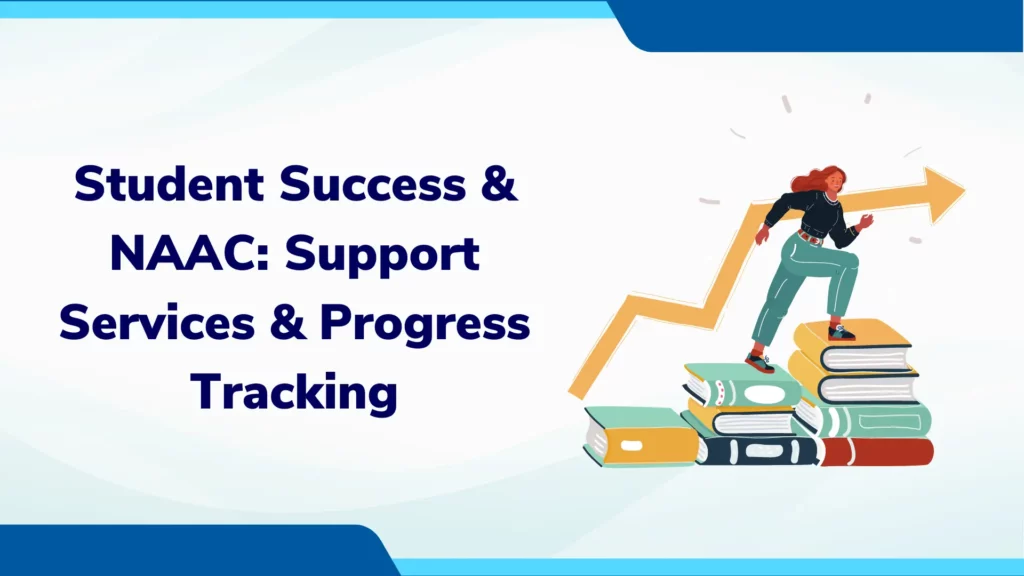
Article Contents
Introduction:
Are you excited to learn about the various criteria for NAAC Accreditation? Let’s get started!
The NAAC is a special organization in India that checks and recognizes how good colleges and universities are. Its main job is to make sure that higher education places provide top-quality education and keep getting better.
When a college or university is accredited by NAAC, it’s like earning a prestigious award. It shows that the institution is really serious about giving the best education possible. There are seven criteria that need to be assessed by the experts while they visit the institutes or universities.
Criterion V is Student Support and Progression. This criterion focuses on how well these places help students with their studies and personal growth. It’s like a big thumbs-up to institutes that support their students in many ways.
The NAAC accreditation body knows that students want to learn and succeed, right? So, Criterion V looks at how institutes create a supportive and friendly environment for students. They want students to feel happy and comfortable while studying.
In the next parts of this article, we will explore the different components of Criterion V in more detail. We will look at how student support services and progression are important. Also, we will learn about methods to track student progress effectively. Plus, we will discover the best practices that institutes can use to improve their scores and get that remarkable NAAC Accreditation.

Understanding Criterion V: Student Support & Progression
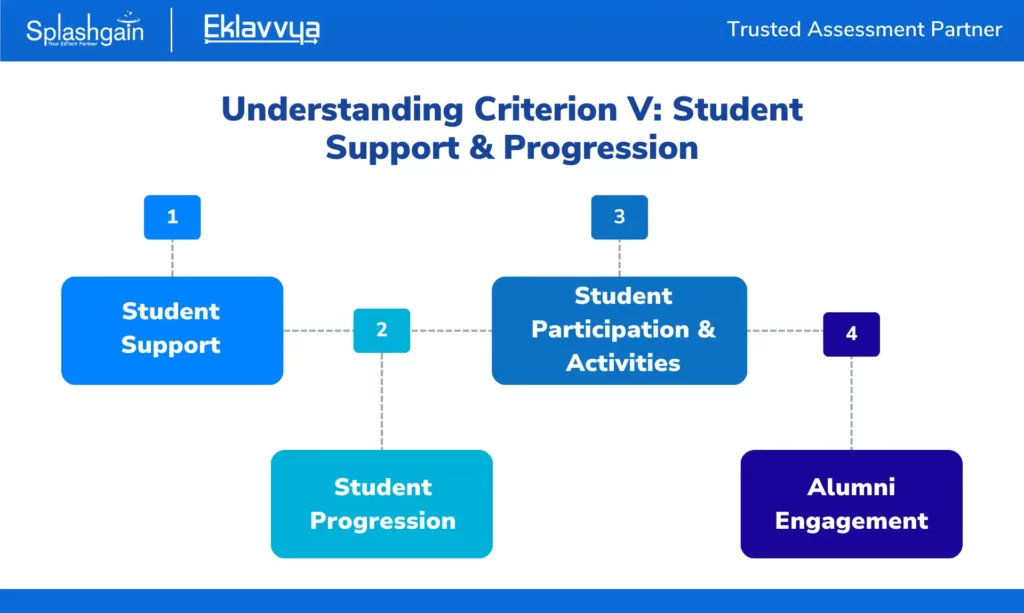
5.1 Student Support
5.1.1 Government Scholarships & Freeships:
The government scholarships and freeships provided by the institution have been instrumental in supporting the academic pursuits of deserving students. Over the years, these financial aids have helped a large number of students in accessing quality education and achieving their career goals.
The number of students benefiting from government scholarships and freeships varies each year, depending on eligibility criteria and available funding. These programs aim to support financially disadvantaged students, promote integration in education, and reduce the burden of educational expenses for deserving individuals.
- Number of beneficiaries influenced by eligibility criteria and available funds.
- Programs designed to support financially challenged students.
- Promotes diversity and inclusivity in higher education.
- Government scholarships and freeships are provided to students annually.
How to Achieve?
- Collaborate with government authorities to identify eligible students.
- Promote scholarship opportunities through various channels to reach potential beneficiaries.
- Streamline the application and selection process to ensure transparency and efficiency.
5.1.2 Institutional and Non-government Scholarships & Freeships:
Apart from government scholarships, the institution can also offer its own scholarships and collaborate with non-government agencies to provide additional financial support to students. These initiatives have played a key role in promoting academic excellence and encouraging students to excel in their studies.
Apart from government initiatives, the institution and non-governmental agencies offer scholarships and freeships to students. These awards are granted based on different criteria, including academic merit, financial need, and specific talents or achievements.
The number of students benefiting from these opportunities may vary each year, depending on the resources available and the criteria set by the awarding bodies.
- Institutions and non-governmental agencies provide scholarships and freeships.
- Criteria may include academic merit, financial need, talents, or achievements.
- Number of beneficiaries influenced by available resources and specific criteria.
- Aims to recognize and support deserving students pursuing higher education.
How to Achieve?
- Establish clear criteria and guidelines for different scholarships and freeships.
- Publicize available scholarships within the institution and externally.
- Encourage donors and alumni to contribute to scholarship funds.
5.1.3 Capacity Development and Skills Enhancement Activities:
The institution should regularly conduct various capacity development and skills enhancement activities to equip students with the necessary competencies for personal and professional growth. These activities are designed to complement the academic curriculum and promote a holistic learning experience.
The institution organizes various capacity development and skills enhancement activities to enrich students’ learning experiences. These activities include workshops, seminars, guest lectures, internships, and industry interactions.
The year-wise list of activities showcases the efforts made to equip students with practical knowledge, technical skills, and soft skills to enhance their employability and overall development.
- Year-wise list of capacity development and skills enhancement activities.
- Activities include workshops, seminars, guest lectures, internships, etc.
- Designed to impart practical knowledge and technical skills.
- Aims to enhance students’ employability and overall development.
How to Achieve?
- Plan a diverse range of workshops, seminars, and training sessions for different disciplines.
- Collaborate with industry partners for internships and practical training opportunities.
- Monitor and evaluate the impact of these activities on students’ skill development.
5.1.4 Guidance for Competitive Examinations and Career Counseling:
The institution must place great emphasis on guiding students towards successful careers and competitive examinations. Career counseling and guidance sessions need to be conducted regularly to help students make informed decisions about their academic and professional paths.
The institution should provide guidance and support to students aspiring to excel in competitive examinations and make informed career choices. Trained counselors and faculty members offer personalized career counseling sessions to help students identify their strengths, interests, and potential career paths.
Additionally, coaching and training programs need to be organized to prepare students for various competitive exams, empowering them to achieve their academic and professional goals.
- Personalized career counseling sessions are offered to students.
- Trained counselors and faculty members assist in career planning.
- Coaching and training programs to prepare for competitive exams.
- Supports students in achieving academic and professional aspirations.
How to Achieve?
- Train faculty members and counselors in effective career counseling techniques.
- Organize workshops and mock tests to help students prepare for competitive exams.
- Maintain a comprehensive database of career opportunities and resources.
5.1.5 Student Grievance Redressal:
The institution needs to prioritize the welfare of its students and ensure a safe and conducive learning environment. To address any grievances, including cases of sexual harassment and ragging, the institution follows a well-defined approach.
The institution should adopt a comprehensive approach to address student grievances, including cases of sexual harassment and ragging. It establishes dedicated grievance redressal committees comprising faculty, staff, and student representatives to handle complaints.
Regular awareness campaigns and sensitization programs are required to be conducted to educate students about the redressal mechanisms, ensuring a safe and supportive learning environment for everyone.
- Dedicated grievance redressal committees were established for handling complaints.
- Committees comprise faculty, staff, and student representatives.
- Regular awareness campaigns and sensitization programs are conducted.
- Emphasizes creating a safe and supportive learning environment.
How to Achieve?
- Establish a dedicated grievance redressal committee with diverse members.
- Conduct regular awareness campaigns on student rights and reporting mechanisms.
- Provide counseling and support services for victims of harassment and ragging.
5.2 Student Progression
5.2.1 Average Percentage of Placement of Outgoing Students during the last five years:
The average percentage of placements achieved reflects the institution’s commitment to nurturing students’ skills and providing them with valuable opportunities for their future careers. Through dedicated efforts and robust industry connections, the institution continues to strive for consistent and improved placement records, ensuring that its graduates transition smoothly into the professional world.
- Keep a detailed record of outgoing students and their placement status.
- Calculate the average percentage of students placed for each of the last five years.
- Include data on placements secured through campus placements, internships, and off-campus opportunities.
- Regularly update and verify the placement data to ensure accuracy.
How to Achieve?
- Collaborate with the institution’s placement cell to maintain up-to-date records.
- Conduct regular placement drives and job fairs to connect students with potential employers.
- Strengthen industry-academia partnerships to increase placement opportunities.
- Provide training and career counseling to enhance students’ employability.
5.2.2 Progression to Higher Education:
The institution takes pride in its students’ academic pursuits and their desire to continue their education beyond the undergraduate level. Over the last five years, it is required to identify a notable number of outgoing students who have shown interest in higher education, pursuing postgraduate studies, research programs, and professional courses.
This trend reflects the institution’s emphasis on academic excellence and its efforts to equip students with the necessary knowledge and skills to succeed in their chosen fields of study.
- Track the number of outgoing students who pursue higher education after completing their current program.
- Categorize the data based on the type of higher education institution (e.g., universities, colleges, research institutes).
- Analyze the trends and identify the most popular disciplines for further studies.
- Maintain data on the number of students pursuing postgraduate studies, research programs, or professional courses.
How to Achieve?
- Conduct regular counseling sessions for students to discuss their options for higher education.
- Provide information on various universities, courses, and scholarship opportunities.
- Encourage students to participate in workshops and seminars related to higher studies.
- Support students in the application process for universities and scholarships.
5.2.3 Competitive Examinations:
The institution’s students have demonstrated exceptional competence and dedication in competitive examinations at various levels, including state, national, and international arenas.
Over the last five years, categorize a commendable percentage of students who have qualified in these exams, earning recognition for their academic skills, research achievements, and talent in sports and other extracurricular activities.
Such outstanding results reflect the institution’s commitment to providing comprehensive education and holistic development, preparing students to excel in diverse competitive environments.
- Keep records of students who appeared for state, national, and international level competitive examinations.
- Track the number of students who qualified in these exams and categorize them by subject or field.
- Calculate the average percentage of students qualifying in competitive exams for the last five years.
- Include data on exams related to academics, research, sports, and other extracurricular activities.
How to Achieve?
- Offer specialized coaching and training programs for competitive examinations.
- Identify talented students early and provide them with additional support and resources.
- Organize mock tests and practice sessions to familiarize students with the exam format.
- Collaborate with subject matter experts and external agencies to enhance students’ preparation.
5.3 Student Participation and Activities:
5.3.1 Awards – Sports and Cultural Activities:
The institution takes immense pride in nurturing a vibrant sports and cultural ecosystem, providing students with ample opportunities to excel in their respective fields.
Over the years, identify students who showcased exceptional talent and dedication, earning numerous awards and medals in various sports and cultural activities at different levels – inter-university, state, national, and even international competitions.
These awards not only highlight the individual achievements of our students but also highlight the institution’s commitment to promoting a holistic learning environment that celebrates and supports diverse talents.
- Keep a comprehensive record of awards and medals won by students in sports and cultural activities.
- Categorize the data based on the level of competition (inter-university, state, national, international).
- Include details of the events in which the students participated and the achievements earned.
- Regularly update the records to maintain accuracy and showcase the institution’s achievements.
How to Achieve?
- Encourage students to participate in sports and cultural activities actively.
- Provide specialized training and coaching for students interested in specific sports and arts.
- Identify talented individuals and nurture their skills through dedicated support and resources.
- Promote a culture of appreciation and recognition for outstanding performances in sports and cultural events.
5.3.2 Student Council:
The institution has to maintain an active and dynamic Student Council, which serves as a crucial bridge between the student community and the academic and administrative bodies of the institution. The Student Council represents the collective voice of the students, advocating for their rights, welfare, and aspirations.
With their active involvement in decision-making processes, the Student Council ensures that students have a say in shaping various policies and initiatives that directly impact their academic journey and overall campus experience.
- Establish a functional Student Council comprising elected student representatives from different departments or programs.
- Ensure regular elections and a fair selection process for student council members.
- Provide a platform for the Student Council to actively engage in the decision-making processes of the institution.
- Encourage student council members to represent the student body on academic and administrative committees.
How to Achieve?
- Conduct regular and transparent elections for student council positions.
- Organize workshops and training sessions to develop leadership and communication skills among student representatives.
- Include student council members in important decision-making meetings to promote student participation.
- Foster a positive and collaborative environment where students feel comfortable expressing their views and concerns.
5.3.3 Institutional Sports and Cultural Events:
The institution must actively promote sports and cultural activities by organizing a diverse range of events and competitions throughout the academic year. These events serve as platforms for students to showcase their talents, foster healthy competition, and cultivate a spirit of camaraderie among the student community.
The information should reflect that Year after year, the institution hosts an increasing number of sports and cultural events, ensuring that there is something for everyone to participate in and enjoy.
- Plan and organize a variety of sports and cultural events throughout the year.
- Include both intra-institutional and intercollegiate competitions in the events calendar.
- Promote active participation from students, faculty, and staff in these events.
- Arrange for necessary facilities, resources, and logistics to conduct successful events.
How to Achieve?
- Create a dedicated events committee responsible for organizing sports and cultural competitions.
- Collaborate with student clubs and societies to engage them in event planning and execution.
- Publicize the events well in advance to attract participants and spectators.
- Offer incentives and recognition for outstanding performers to encourage active participation.
5.4 Alumni Engagement
5.4.1 Registered Alumni Association:
The institution takes great pride in its strong and active Alumni Association and its various chapters. The Alumni Association plays a vital role in contributing significantly to the development and progress of the institution.
Through their continued engagement and involvement, alumni provide valuable support services, both financial and non-financial, that have a lasting impact on the institution’s growth.
The association serves as a bridge between the alumni and the alma mater, fostering a sense of belonging and nurturing a strong network of graduates who remain committed to the institution’s success.
- Establish an official Alumni Association for the institution.
- Register the association as a legal entity with relevant authorities.
- Organize regular meetings and events to engage alumni with the institution.
- Encourage active participation of alumni in various development initiatives.
- Collaborate with alumni to provide financial and other support services for the institution’s growth.
How to Achieve?
- Create a dedicated alumni relations team to manage the association’s activities.
- Maintain a database of alumni with their contact information.
- Promote networking events, reunions, and mentorship programs to foster a strong alumni community.
- Seek alumni input on institutional development plans and projects.
- Recognize and appreciate the contributions of alumni to encourage continued engagement.
5.4.2 Alumni Financial Contribution:
The alumni association plays an important role in financial contribution. Make sure that over the last five years, the Alumni Association has made substantial financial contributions to the institution. These contributions, in the form of donations, endowments, sponsorships, and scholarships, have been instrumental in enhancing the infrastructure, facilities, and academic resources of the institution.
The generosity of the alumni has allowed the institution to implement various developmental projects, support deserving students in their educational pursuits, and strengthen research and innovation initiatives. Their financial support demonstrates the unwavering commitment of the alumni towards the institution’s mission and their belief in giving back to their alma mater.
- Keep detailed records of alumni’s financial contributions over the last five years.
- Categorize contributions based on specific projects or funds they supported.
- Maintain transparency in financial transactions and record-keeping.
- Regularly communicate with alumni about the impact of their contributions.
- Encourage recurring contributions and set up donation campaigns.
How to Achieve?
- Implement an efficient donation and contribution tracking system.
- Create personalized communication strategies to engage alumni and encourage donations.
- Highlight success stories and achievements resulting from alumni contributions.
- Offer various giving options, such as one-time donations, monthly pledges, and legacy giving.
- Express gratitude to donors through personalized thank-you messages and recognition programs.
The Significance of Student Support Services
Student support services play a pivotal role in enhancing both the academic and personal development of students. These services provide a support system that helps students navigate challenges, ensuring they can fully engage in their educational journey.
Academic support services offer tutoring, counseling, and study skills assistance, leading to improved academic performance and increased confidence. Personal development services, such as career counseling and mental health support, foster self-awareness and emotional well-being, enabling students to grow holistically.
Ultimately, these student support services create a nurturing environment that empowers students to thrive academically and develop essential life skills for a successful future.
Student Support Services for Excellence
1. Libraries and Academic Resources:
Libraries are important student support services that positively affect Criterion V scores. They offer students access to a wide range of academic materials, like books, journals, and digital resources. With the help of librarians, students can easily find the information they need for their studies, creating a better learning environment for academic success.
2. Computer Labs and Technology Support:
Computer labs with up-to-date technology are crucial for Criterion VI evaluation. These labs provide students with access to advanced software and hardware, improving their computer skills and knowledge. Technology support teams help students with any technical issues, making sure technology enhances their learning experiences and contributes to better Criterion V scores.
3. Academic Advising and Mentoring Programs:
Academic advising and mentoring programs are significant for higher Criterion V scores. Through personalized guidance, advisors help students plan their academic journey and set achievable goals. One-on-one mentoring assists students in overcoming challenges and staying motivated, leading to improved retention rates and academic achievements, which positively impact Criterion V evaluations.
Challenges in Student Support Services
Effective student support services are essential for promoting academic success and personal growth. However, various challenges can make it demanding to provide these services. Limited funds and resource allocation can hinder the development of comprehensive support programs.
Problems with staffing and training may affect the quality and availability of assistance. Cultural and social barriers might discourage students from seeking help, leading to less utilization of available services.
To overcome these obstacles, institutions must plan strategically, work together, and focus on students’ needs to ensure they receive the support they require to do well.
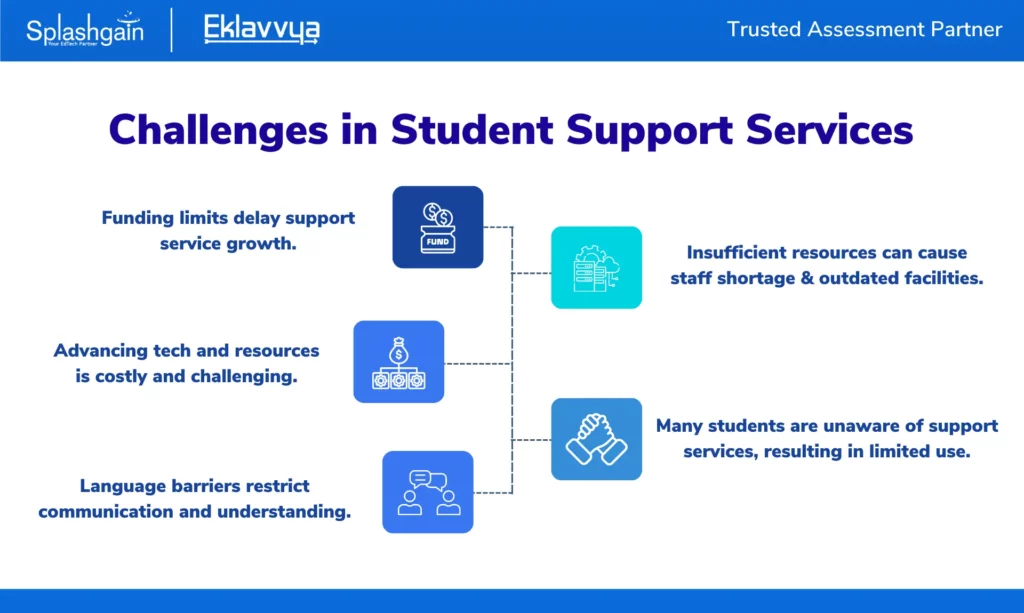
- Limited funding may restrict the development and expansion of support services.
- Inadequate allocation of resources can lead to insufficient staffing and outdated facilities.
- The cost of implementing advanced technologies and modern resources may pose challenges.
- Language and cultural differences can make it difficult to communicate and understand each other.
- Many students may not know about the available support services, leading to limited use.
Valuable support of NAAC software
The NAAC accreditation software plays a vital role in supporting the institution’s grievance redressal process. The software facilitates efficient management and documentation of grievances and enhances transparency in the resolution process.
- Centralized database for accuracy and effortless retrieval.
- Collects, organizes, and manages data on placements, higher education progression, and competitive exam results.
- Assists in maintaining a comprehensive database of alumni.
- Enables the institution to conduct surveys and gather feedback from alumni.
- Utilizes data and analytics as evidence during the NAAC accreditation process.
- Demonstrates the institution’s performance in different areas.
- Supports overall evaluation and assessment.

Conclusion
In conclusion, Criterion V holds immense significance in NAAC accreditation as it evaluates student support services that contribute to academic excellence and personal development. These services, including libraries, academic resources, computer labs, technology support, and academic advising, play a pivotal role in nurturing students’ learning journeys.
The tracking of student progression to higher education and success in competitive examinations reflects the institution’s dedication to preparing students for future endeavors.
Emphasizing the value of student support services and continuous progression tracking underscores the institution’s commitment to fostering a supportive learning environment. By providing comprehensive support, institutions empower students to overcome challenges and achieve their full potential. Additionally, monitoring their progress ensures a holistic approach to education, ensuring that no student is left behind.
Encouraging continuous improvement is vital for enhancing student success and institutional growth. Institutions must adapt and refine support services based on student needs and feedback. By striving for excellence and actively seeking ways to better support students, institutions can create a thriving educational ecosystem where every individual can flourish.
In short, the journey towards effective student support services does not end with accreditation; it is an ongoing process driven by the commitment to student success and holistic development. Through collaborative efforts and a student-centric approach, institutions can foster an environment where students are equipped with the tools and support they need to thrive academically and personally.
